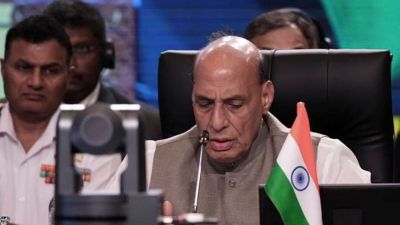Stay updated with the latest - Click here to follow us on Instagram
British Chimpanzee expert Jane Goodall dies at 91: A pictorial tribute to her life and legacy
Goodall, who went on to become one of the world’s most recognised conservationists, died at the age of 91 in California while on a US speaking tour.
 Jane Goodall looks at one the of gorillas at Budapest Zoo in Hungary, Feb 11, 2008. (Photo: AP)
Jane Goodall looks at one the of gorillas at Budapest Zoo in Hungary, Feb 11, 2008. (Photo: AP) Jane Goodall’s first major discovery came in 1960, when she watched a chimpanzee in Tanzania fashion a twig into a tool to fish termites from a nest — a behaviour then thought to be unique to humans. That discovery redefined science’s understanding of the natural world and set the course for six decades of work that reshaped how people see their closest living relatives.
 Jane Goodall photographed next to a chimp enclosure on November 20, 1970. (Photo: San Francisco Chronicle via AP)
Jane Goodall photographed next to a chimp enclosure on November 20, 1970. (Photo: San Francisco Chronicle via AP)
Goodall, who went on to become one of the world’s most recognised conservationists, died Wednesday at the age of 91 in California while on a U S speaking tour.
Living among chimpanzees
Goodall first entered the forests of Gombe in Tanzania in 1960. Without a college degree but backed by anthropologist Louis Leakey, she began studying chimpanzees at close range. She gave them names, documented their social bonds, and discovered their use of tools.
 Jane Goodall kisses Tess, a female chimpanzee, at the Sweetwaters Chimpanzee Sanctuary near Nanyuki, north of Nairobi, on Dec 6, 1997. (Photo: AP)
Jane Goodall kisses Tess, a female chimpanzee, at the Sweetwaters Chimpanzee Sanctuary near Nanyuki, north of Nairobi, on Dec 6, 1997. (Photo: AP)
Her findings reached a wide audience through National Geographic in the 1960s. An image of Goodall crouched across from the infant chimpanzee Flint became an iconic photograph of her research. Her work showed that chimpanzees had individual personalities, long-term bonds, and even engaged in conflict.
 British anthropologist Jane Goodall pictured in 1975, location unknown. (Photo: AP)
British anthropologist Jane Goodall pictured in 1975, location unknown. (Photo: AP)
A global figure
Born in London in 1934, Goodall’s fascination with animals began in childhood. At age 10 she read ‘Tarzan of the Apes’ and decided to live among wild animals. That dream carried her to Africa in 1957, where she met Leakey and began the work that defined her life.
 Jane plays with Bahati, a 3-year-old female chimpanzee, at the Sweetwaters Chimpanzee Sanctuary near Nanyuki, north of Nairobi, on Dec 6, 1997. (Photo: AP)
Jane plays with Bahati, a 3-year-old female chimpanzee, at the Sweetwaters Chimpanzee Sanctuary near Nanyuki, north of Nairobi, on Dec 6, 1997. (Photo: AP)
Goodall received international honours including the US Presidential Medal of Freedom in 2025 and the Templeton Prize in 2021.
 President Joe Biden presents the Presidential Medal of Freedom to conservationist Jane Goodall in the East Room of the White House on Jan 4, 2025. (Photo: AP)
President Joe Biden presents the Presidential Medal of Freedom to conservationist Jane Goodall in the East Room of the White House on Jan 4, 2025. (Photo: AP)
Tributes poured in following her death. UN Secretary-General António Guterres said, “I’m deeply saddened to learn about the passing of Jane Goodall, our dear Messenger of Peace. She is leaving an extraordinary legacy for humanity & our planet.” British broadcaster Chris Packham said, “Jane died on the job, the job that her life became. And that was protecting life on earth.”
 Jane Goodall pictured at the Four Seasons Clift Hotel in San Francisco on Oct 11, 1990. (Photo: Tom Levy/San Francisco Chronicle via AP)
Jane Goodall pictured at the Four Seasons Clift Hotel in San Francisco on Oct 11, 1990. (Photo: Tom Levy/San Francisco Chronicle via AP)
From scientist to activist
By the mid-1980s, Goodall shifted from research to advocacy after witnessing footage of laboratory experiments on animals. She went on to campaign globally for conservation, animal welfare, and climate action. Even into her 90s, she travelled for nearly 300 days a year to address audiences, often beginning her talks by imitating a chimpanzee call.
 Jane Goodall addresses a Harvard Law School symposium titled, ‘The Evolving Legal Status of Chimpanzees’ in Cambridge, 2022 (Photo: AP Photo)
Jane Goodall addresses a Harvard Law School symposium titled, ‘The Evolving Legal Status of Chimpanzees’ in Cambridge, 2022 (Photo: AP Photo)
Goodall was scheduled to plant trees with students in wildfire burn zones in Los Angeles Wednesday when news of her death reached organisers. A tree was planted in her name after a moment of silence.





- 01
- 02
- 03
- 04
- 05


























